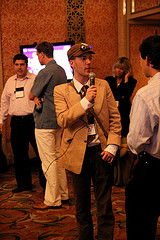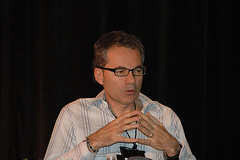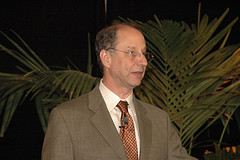
SAN FRANCISCO — In my account of Supernova 2007 yesterday, I didn’t mention one of the things that really irked me about the conference: the silence. When panelists were on the huge stage at the main ballroom in the Westin St. Francis Hotel, the large audience sat silent typing away at their laptops.
While some sessions ended with a formal Q&A in which attendees got up and made the long trek to the microphone, most stayed put, making the sessions more like speeches than participatory discussions. With a room full of such smart people, you’d think they’d have a lot more to contribute, but the talking didn’t really begin until the breaks, when entrepreneurs were pitching their products left and right, and full-on business schmoozing was overflowing into the hallways.
On the second day of the conference, I attended a panel called “The Social Web.” What I found immediately interesting about this panel is that the products and companies represented were extremely diverse, ranging from a social WiFi telephony site to traditional portals. Moderator and Supernova co-founder Kevin Werbach introduced what he described as an increasing trend: As the web becomes more social, it also becomes more personalized. As we are out there networking with the world on MySpace and LinkedIn, we also are closing ourselves to information that we feel isn’t relevant to us, by picking and choosing our media and how we consume it.
“So what’s next for the social web?” Werbach asked the panel.
Up first was Mike Speiser, whose team works on Yahoo Groups, Yahoo 360 and other community products. Speiser said Yahoo is moving more toward “discovery” (a buzzword that came up a lot in yesterday’s pitching sessions) and personalization. He said that each person that uses the product improves the experience for the next user. An example would be if a lot of people are clicking on a link to a certain story, Yahoo might promote that link with more prominence. The company is also trying to take user data to suggest stories, in an Amazon-like recommendation: “people who like this also like this.” Speiser says the web is going from “publish and subscribe” to users actually improving the products they use.
Greg Reinacker of NewsGator said something similar. On NewsGator, a company that develops RSS feed readers, what’s “bubbled up to the top” is content that users are interacting with most, driving more interest from other people. Reinacker also wondered how media brands will deal with the fact that people are moving away from having CNN.com as a homepage to a more personalized experience. That shift means more business and traffic for NewsGator and other aggregators, who can syndicate content onto different sites to meet the growing demand.

Also on the panel was Martin Varsavsky, the CEO of FON, a company that lets people connect to each other by sharing wireless routers, creating an interesting community of folks who share ad hoc Internet access. Varsavsky is a Spanish-Argentine entrepreneur who is quite a celebrity in the Spanish-speaking Internet world, so I was anxious to hear his take on all of this. I wasn’t disappointed, as he actually went beyond the tech side to talk about users as people.
Varsavsky pointed out the differences between American Internet users and those from Latin America or Spain. “In the Spanish world, they like physical contact,” he said. “They like to look at people, they like to touch people.” He said that as the popularity of the Internet began to grow in Spain, users immediately used it to meet up offline for parties. FON lets users do that with the people around them, as neighbors share WiFi routers then use the service to network with people physically close to them.
He also made a good point about these cultural differences, using the conference and its silence as an example.
“This looks like a press conference, with everyone looking at their computers,” he said, referring to the sea of laptops in perfect lines that filled the ballroom. “If this were a conference in a Spanish-speaking country, we probably wouldn’t be looking at the people on the stage or at the screens; we’d all be talking to each other.”
I think this sums up not only why his product is right for his markets, but why Americans are so obsessed with our online lives. Even in a room full of people with similar interests, we’re incapable of talking to each other if it isn’t via IM or email. The point was driven home even more as I received an email from a person who was sitting about 20 feet away from me.
The Politics of Governing the Internet
Seeing the conference in bits and pieces and taking the panel sessions at face value, it might be hard to see how all of this ties into the event’s theme of decentralization. After the “Social Web” session I had a chance to talk with renowned Internet thinker David Weinberger, a fellow at Harvard’s Berkman Center for the Internet & Society. His latest book is Everything is Miscellaneous: The Power of the New Digital Disorder, and he explained to me why the conversations taking place at Supernova were important.
“The old means of communication required a certain degree of centralization: broadcast,” he said. “It’s very expensive to get on, it has a very strict audience vs. speaker dynamic, but all of that goes away as the person-to-person network becomes more important. This makes the question of ‘who owns the Internet?’ that much more important, and ultimately impacts media, both online and traditional.”

Weinberger said that attendees — whom he described as a mix of hardcore telecom people and those building online communities — are dependent on each other even though they are often treated separately. He said that Supernova was a good place to see how the web’s infrastructure is having a direct effect on what we can and cannot do online.
Weinberger also said that the infrastructure issue has both political and cultural weight, as many people believe that multimedia such as online video will eventually strain the Internet’s backbone to a breaking point. I told him I thought the issue of scalability, whether the Internet could scale to deal with all that traffic, seemed to come up a lot in the panel discussions, and wondered what effect that would have on how we use the Internet.
“Scalability came up from the very beginning, and it’s where these two levels actually touch,” he said. “The web came about only because it’s scalable and it’s scalable only because it’s unowned and there’s no permission required to be on it. There are no managers, and if there were, it wouldn’t scale. Now we need to decide whether — now that the Internet is ‘all grown up’ — it needs more management. That’s an active political issue and how that plays out actually determines what kind of applications you can have. For example, the providers of the current infrastructure have made the decision that we need more bandwidth coming down, to download stuff. And that’s based on the assumption — which has never been true, by the way — that people who use the web are like people who watch TV.”
This conversation with Weinberger happened, of course, off-stage in a corridor, and was for me a better representation of what this conference was about than what I actually saw on the panels. The idea behind the conference is extremely compelling when you think of the urgency of the issues he talks about here — the cultural and political ramifications of business intersecting with the Internet.
Unfortunately, to an observer like me, that issue wasn’t immediately evident in the panels. That might be due to the fact that most of the attendees are of the opinion that the Internet does not need management, making it a moot point. As Weinberger puts it: “It’s a battle — the struggle for the Internet. Who owns it and whether it’s going to be owned or not. That issue is coming to a head. The discussion around it is ever more passionate and the lines are drawn more firmly. Supernova tends to be on one side of that issue, and that’s fine by me.”
Here’s what other folks thought about Supernova 2007:
Dylan Tweney on Wired’s Epicenter blog wrote that it was “an impressive muster of brainpower and business clout. On the other hand, the presentations onstage were mind-numbingly boring.”
JD Lasica of SocialMedia.biz discusses the first day of the conference.
David Weinberger discusses some of the more interesting sessions on his blog, among them Denise Caruso’s take on anti-social software.
Supernova’s Conversation Hub blog has blog posts summarizing each of the panels for the entire conference, as well as some video interviews with panelists.
What do you think about Supernova 2007? Did you attend the conference and what did you think were its stronger and weaker points? Share your thoughts in the comments below.
Jennifer Woodard Maderazo is the associate editor of PBS MediaShift. She is a San Francisco-based writer, blogger and marketer, who covers Latino marketing at Latin-Know and Latino cultural issues at VivirLatino.
Photo of Nick Douglas by Jennifer Woodard Maderazo. Photos of Martin Varsavsky and David Weinberger by Dan Farber.
You can see more of Jennifer’s photos from Supernova 2007 on Flickr, and you can see more photos from the conference taken by other attendees here.

hey Jennifer…I was at Supernova, too. I did a small presentation (*very* small) on Assignment Zero on Wednesday at one of the Challenge Roundtables. I also wrote about the Social Web panel–and caution how we should *not* consider the clannishness of Facebook to be the model of how people really use social media…
It’s more like the model for how A Small World operates…
I, too, felt there was a disconnect between the world of people who actually socialize on the Internet (and are active social media users) with those who simply stand back and observe.
Yet I was glad to see the panel between Weinberger and Keen not devolve into a slugfest–regardless of their differences, these are two guys who weren’t going to feed the “bloodlust” of some folks in the crowd. Good thing too, as they both had seriously important things to say…
BTW, today, danah boyd has some interesting stuff to say about the social class issues endemic to Facebook….perhaps Keen’s right to be concerned about The Masses after all.